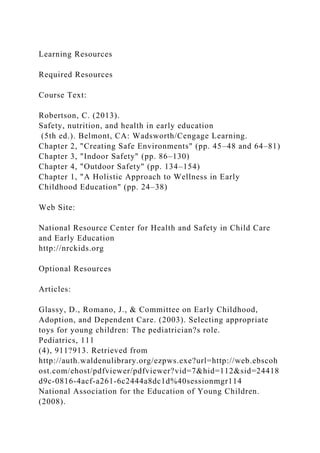Learning ResourcesRequired ResourcesCourse TextRobertso.docx
Learning Resources Required Resources Course Text: Robertson, C. (2013). Safety, nutrition, and health in early education (5th ed.). Belmont, CA: Wadsworth/Cengage Learning. Chapter 2, "Creating Safe Environments" (pp. 45–48 and 64–81) Chapter 3, "Indoor Safety" (pp. 86–130) Chapter 4, "Outdoor Safety" (pp. 134–154) Chapter 1, "A Holistic Approach to Wellness in Early Childhood Education" (pp. 24–38) Web Site: National Resource Center for Health and Safety in Child Care and Early Education http://nrckids.org Optional Resources Articles: Glassy, D., Romano, J., & Committee on Early Childhood, Adoption, and Dependent Care. (2003). Selecting appropriate toys for young children: The pediatrician?s role. Pediatrics, 111 (4), 911?913. Retrieved from http://auth.waldenulibrary.org/ezpws.exe?url=http://web.ebscohost.com/ehost/pdfviewer/pdfviewer?vid=7&hid=112&sid=24418d9c-0816-4acf-a261-6c2444a8dc1d%40sessionmgr114 National Association for the Education of Young Children. (2008). Good toys for young children . Retrieved November 18, 2008, from http://www.naeyc.org/ecp/resources/goodtoys Smith, C. A. (1987). Toy safety . Retrieved from National Network for Child Care: http://www.nncc.org/Health/toy.safety.html Goodson, B., & Bronson, M. (1993). Which toy for which child: A consumer's guide for selecting suitable toys (ages birth through five) [Pamphlet]. Retrieved from U.S. Consumer Product Safety Commission: http://www.cpsc.gov/cpscpub/pubs/285.pdf Web Sites: About Anaphylaxis http://www.epipen.com/allergicemergencies/allergic-emergency American Academy of Pediatrics: Parenting Corner Q & A: Anaphylaxis http://www.healthychildren.org/English/health-issues/injuries-emergencies/Pages/Anaphylaxis.aspx National Program for Playground Safety http://playgroundsafety.org/ Playground Safety http://kidshealth.org/parent/firstaid_safe/outdoor/playground.html Safe Kids Worldwide http://www.safekids.org/ Safety, Nutrition, and Health Goals As you read in the "Designing a Safety Policy" section in Chapter 2 (pp. 47–48) and pp. 24–38 of your course text, high-quality programs and environments for young children should strive to meet six goals: 1. Maximize children's health status. 2. Minimize the risks to children's health, safety, and well-being. 3. Teach and model good health practices and risk reduction for both children and adults. 4. Recognize the importance of guidelines, standards, and laws as they apply to the health, safety, and well-being of children. 5. Practice cultural competence. 6. Develop partnerships with families to provide a caring community. Carefully consider each of these goals and select two that are of most interest to you. With these thoughts in mind: By Day 3: Post a response to the following: Identify the two goals you selected and explain in your own words why they are important to achieve in an early childhood environment. Describe challenges you might encounter as you pursue these goals in your future wo.

Empfohlen
Empfohlen
Weitere ähnliche Inhalte
Ähnlich wie Learning ResourcesRequired ResourcesCourse TextRobertso.docx
Ähnlich wie Learning ResourcesRequired ResourcesCourse TextRobertso.docx (11)
Mehr von festockton
Mehr von festockton (20)
Kürzlich hochgeladen
Kürzlich hochgeladen (20)
Learning ResourcesRequired ResourcesCourse TextRobertso.docx
- 1. Learning Resources Required Resources Course Text: Robertson, C. (2013). Safety, nutrition, and health in early education (5th ed.). Belmont, CA: Wadsworth/Cengage Learning. Chapter 2, "Creating Safe Environments" (pp. 45–48 and 64–81) Chapter 3, "Indoor Safety" (pp. 86–130) Chapter 4, "Outdoor Safety" (pp. 134–154) Chapter 1, "A Holistic Approach to Wellness in Early Childhood Education" (pp. 24–38) Web Site: National Resource Center for Health and Safety in Child Care and Early Education http://nrckids.org Optional Resources Articles: Glassy, D., Romano, J., & Committee on Early Childhood, Adoption, and Dependent Care. (2003). Selecting appropriate toys for young children: The pediatrician?s role. Pediatrics, 111 (4), 911?913. Retrieved from http://auth.waldenulibrary.org/ezpws.exe?url=http://web.ebscoh ost.com/ehost/pdfviewer/pdfviewer?vid=7&hid=112&sid=24418 d9c-0816-4acf-a261-6c2444a8dc1d%40sessionmgr114 National Association for the Education of Young Children. (2008).
- 2. Good toys for young children . Retrieved November 18, 2008, from http://www.naeyc.org/ecp/resources/goodtoys Smith, C. A. (1987). Toy safety . Retrieved from National Network for Child Care: http://www.nncc.org/Health/toy.safety.html Goodson, B., & Bronson, M. (1993). Which toy for which child: A consumer's guide for selecting suitable toys (ages birth through five) [Pamphlet]. Retrieved from U.S. Consumer Product Safety Commission: http://www.cpsc.gov/cpscpub/pubs/285.pdf Web Sites: About Anaphylaxis http://www.epipen.com/allergicemergencies/allergic-emergency American Academy of Pediatrics: Parenting Corner Q & A: Anaphylaxis http://www.healthychildren.org/English/health-issues/injuries- emergencies/Pages/Anaphylaxis.aspx National Program for Playground Safety http://playgroundsafety.org/ Playground Safety http://kidshealth.org/parent/firstaid_safe/outdoor/playground.ht ml Safe Kids Worldwide http://www.safekids.org/ Safety, Nutrition, and Health Goals
- 3. As you read in the "Designing a Safety Policy" section in Chapter 2 (pp. 47–48) and pp. 24–38 of your course text, high-quality programs and environments for young children should strive to meet six goals: 1. Maximize children's health status. 2. Minimize the risks to children's health, safety, and well- being. 3. Teach and model good health practices and risk reduction for both children and adults. 4. Recognize the importance of guidelines, standards, and laws as they apply to the health, safety, and well-being of children. 5. Practice cultural competence. 6. Develop partnerships with families to provide a caring community. Carefully consider each of these goals and select two that are of most interest to you. With these thoughts in mind: By Day 3: Post a response to the following: Identify the two goals you selected and explain in your own words why they are important to achieve in an early childhood environment. Describe challenges you might encounter as you pursue these goals in your future work with children and families. How might you or another adult working with young children overcome these challenges? Draw on specific examples from the readings and, if possible, your own experiences to substantiate your thinking.